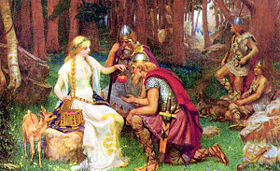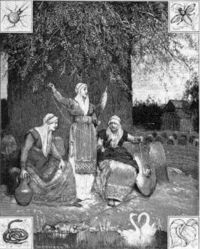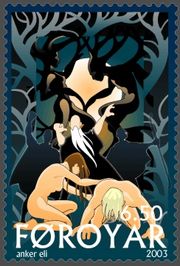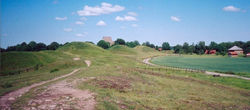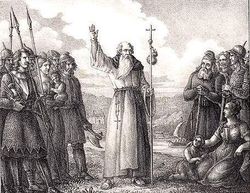Norse mythology
2008/9 Schools Wikipedia Selection. Related subjects: Myths
|
Norse, Viking or Scandinavian mythology comprises the indigenous pre-Christian religion, beliefs and legends of the Scandinavian peoples, including those who settled on Iceland, where most of the written sources for Norse mythology were assembled. Norse mythology is the best-preserved version of the older common Germanic paganism, which also includes the closely related Anglo-Saxon mythology. Germanic mythology, in its turn, developed from an earlier Indo-European mythology.
Norse mythology is a collection of beliefs and stories shared by Northern Germanic tribes. It had no one set of doctrinal beliefs. The mythology was orally transmitted in the form of poetry and modern knowledge about it is mainly based on the Eddas and other medieval texts written down during and after Christianization.
Some aspects of Norse mythology passed into Scandinavian folklore and have survived to modern day. Others have recently been reinvented or reconstructed as Germanic neopaganism. The mythology also remains as an inspiration in literature (see Norse mythological influences on later literature) as well as on stage productions and movies.
Cosmology
Scandinavians believed there are ' nine worlds' (níu heimar), that many scholars summarize as follows:
- Ásgarðr, world of the Æsir.
- Vanaheimr, world of the Vanir.
- Miðgarðr, world of humans.
- Muspellheim, world of the primordial element of fire.
- Niflheimr, world of the primordial element of ice
- Hel, underworld, world of the dead.
- Álfheimr, world of the Álfar ( elves).
- Svartalfheim or Nidavellir, world of the Dvergar ( Norse dwarves).
- Jötunheimr, world of the Jötnar (giants).
Note the boundaries between Niflheim, Jötunheimr, Hel, Niðavellir, Svartálfaheimr, and several other significant places like Utgarðr remain uncertain.
Each world also had significant places within. Valhalla was Odin's hall located in Asgard. It was also home of the Einherjar, who were the souls of the greatest warriors. These warriors were selected by the Valkyries, Odin's mounted female messengers whose sparkling armor supposedly created the famed Aurora Borealis, or the northern lights. The Einherjar would help defend the gods during Ragnarok, when everyone would die in a great battle between the gods and their iniquitous enemies. A battle, incidentally, emphasising an order-versus-chaos duality common to many ancient mythologies and no less present in Norse mythology. Niflhel was a hellish place in Hel, where oathbreakers and other criminals suffered torments (compare Greek Tartarus).
These worlds were connected by Yggdrasil, or the world ash root, a giant tree with Asgard at its top. Chewing at its roots in Niflheim was Nidhogg, a ferocious serpent or dragon. Asgard can also be reached by Bifrost, the magical rainbow bridge guarded by Heimdall, the mute god of vigilance who could see and hear a thousand miles.
The cosmology of Norse mythology also involves a strong element of duality; for example the night and the day have their own mythological counterparts-- Dagr/ Skinfaxi and Nótt/ Hrímfaxi, the sun Sól and the chasing wolf Skoll, the moon Mani and its chasing wolf Hati, and the total opposites of Niflheim and Muspell in the origin of the world. This might have reflected a deeper metaphysical belief in opposites as the foundation of the world.
Supernatural beings
There are several "clans" of Vættir or animistic nature spirits: the Æsir and Vanir, understood as gods, plus the Jötnar, the Álfar and Dvergar. To this list can be added the dead in the Underworld. The distinction between Æsir and Vanir is relative, for the two are said to have made peace, exchanged hostages, intermarried and reigned together after a prolonged war, which the Æsir had finally won. Some gods belong in both camps. Some authorities (compare Mircea Eliade and J.P. Mallory) consider the Æsir/Vanir division to be simply the Norse expression of a general Indo-European division of divinities, parallel to that of Olympians and Titans in Greek mythology and to a similar structure in parts of the Mahabharata.
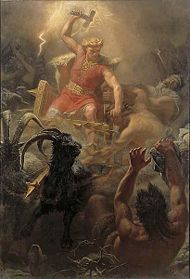
Generally, despite ambiguity, the Æsir and their allies represent the natural forces of cosmic order, whereas the Jötnar represent the natural forces of destructive chaos. The Jötnar compare to the Titans and Gigantes of Greek mythology and generally translated as "giants", although " trolls" and " demons" have been suggested as suitable alternatives. Notably, a foreboding figure like Loki was the child of two giants, and likewise Hel his daughter. Even so, the Æsir frequently intermarry the Jötnar, and themselves for the most part descend from them. Loki himself is thought to be the blood brother of Óðinn and thus counted as one of the Æsir. Some of the giants are mentioned by name in the Eddas, and they seem to be representations of natural forces. There are two general types of giant: Thurses and the normal thuggish giant, but there was also a giant made of stone and a giant made of fire. There were also elves and dwarfs, whose role is shadowy but who are generally thought to side with the gods.
In addition, there are many other supernatural beings: Fenrir the gigantic wolf, and Jörmungandr the sea-serpent (or "worm") that is coiled around Midgard. These two monsters are described as the progeny of Loki. More benevolent creatures are Hugin and Munin (thought and memory, respectively), the two ravens who keep Odin, the chief god, apprised of what is happening on earth, since he gave his eye to the Well of Mimir in his quest for wisdom, Sleipnir, Loki's eight legged horse son belonging to Odin and Ratatosk, the squirrel which scampers in the branches of Yggdrasil.
Along with many other polytheistic religions, this mythology lacks the good-evil dualism of the Middle Eastern tradition. Thus, Loki is not primarily an adversary of the gods, though he is often portrayed in the stories as the nemesis to the protagonist Thor, and the giants are not so much fundamentally evil, as rude, boisterous, and uncivilized (except in the case of the Thurses who were not quite so uncivilized). The dualism that exists is not good vs. evil, but order vs. chaos. The gods represent order and structure whereas the giants and the monsters represent chaos and disorder.
Völuspá: the origin and end of the world
The origin and eventual fate of the world are described in Völuspá ("Prophecy [spá] of the völva"), one of the most striking poems in the Poetic Edda. These haunting verses contain one of the most vivid creation accounts in all of religious history and a representation of the eventual destruction of the world that is unique in its attention to detail.
In the Völuspá, Odin, the chief god of the Norse pantheon, has conjured up the spirit of a dead völva and commanded this spirit to reveal the past and the future. She is reluctant: "What do you ask of me? Why tempt me?"; but since she is already dead, she shows no fear of Odin, and continually taunts him: "Well, would you know more?" But Odin insists: if he is to fulfill his function as king of the gods, he must possess all knowledge. Once the völva has revealed the secrets of past and future, she falls back into oblivion: "I sink now".
The beginning
According to Norse myth, the beginning of life was fire and ice, with the existence of only two worlds: Muspelheim and Niflheim. When the warm air of Muspelheim hit the cold ice of Niflheim, the giant Ymir and the icy cow Audhumla were created. Ymir's foot bred a son and a man and a woman emerged from his armpits, making Ymir the progenitor of the Jotun, or giants. Whilst Ymir slept, the intense heat from Muspelheim made him sweat, and he sweated out Surtr, a giant of fire. Later Ymir woke and drank Audhumbla's milk. Whilst he drank, the cow Audhumbla licked on a salt stone. On the first day after this a man's hair appeared on the stone, on the second day a head and on the third day an entire man emerged from the stone. His name was Búri and with an unknown giantess he fathered Bor, the father of the three gods Odin, Vili and Ve.
When the gods felt strong enough they killed Ymir. His blood flooded the world and drowned all of the giants, except two. But giants grew again in numbers and soon there were as many as before Ymir's death. Then the gods created seven more worlds using Ymir's flesh for dirt, his blood for the Oceans, rivers and lakes, his bones for stone, his brain as the clouds, his skull for the heaven. Sparks from Muspelheim flew up and became stars.
One day when the gods were walking they found two tree trunks. They transformed them into the shape of humans. Odin gave them life, Vili gave them mind and Ve gave them the ability to hear, see, and speak. The gods named them Ask and Embla and built the kingdom of Middle-earth for them and to keep the giants out the gods placed a gigantic fence made of Ymir's eyelashes around Middle-earth.
The völva goes on to describe Yggdrasil and the three norns (female symbols of inexorable fate; their names - Urðr ( Urd), Verðandandi ( Verdandi), and Skuld - indicate the past, present, and obligatory actions to occur), who spin the threads of fate beneath it. She then describes the war between the Æsir and Vanir and the murder of Baldr, Odin's handsome son whom everyone but Loki loved. (The story is that everything in existence promised not to hurt him except mistletoe. Taking advantage of this weakness, Loki made a mistletoe spear and tricked Höðr, Odin's blind son and Baldr's brother, into using it to kill Baldr. Hel said she would revive him if everyone in the nine worlds wept. A giantess - Thokk, who may have been Loki in shape-shifted form - did not weep. After that she turns her attention to the future.
The end times ( Eschatological beliefs)
The Old Norse vision of the future is bleak. Norse mythology's vision of the end times is stark and pessimistic: not only are the Norse gods capable of being defeated by residents of Yggdrasil's other branches, but in fact are destined to be defeated, and have always lived with this knowledge. In the end, it was believed, the forces of chaos will outnumber and overcome the divine and human guardians of order. Loki and his monstrous children will burst their bonds; the dead will sail from Niflheim to attack the living. Heimdall, the watchman of the gods, will summon the heavenly host with a blast on his horn. Then a final battle will ensue between order and chaos (Ragnarök), which the gods will lose, as is their fate. The gods, aware of this, will gather the finest warriors, the Einherjar, to fight on their side when the day comes, but in the end they will be powerless to prevent the world from descending into the chaos out of which it has once emerged; the gods and their world will be destroyed. There are two optimistic facts, however: Not only will chaos also be defeated, but a new, better world will emerge from the ashes of the old one. Odin will be swallowed by Fenrir. Thor will kill Jörmungandr, but will drown in its venom. Loki will be the last to die, having taken a wound from Heimdall that, although was taken at the same time as Loki's wound on Heimdall, did not kill the god of chaos and fire in that instance.
And although the gods were destined to be defeated and killed, Baldr and Hodr, along with the new world, will be born again.
Kings and heroes
The mythological literature relates the legends of heroes and kings, as well as supernatural creatures. These clan and kingdom founding figures possessed great importance as illustrations of proper action or national origins. The heroic literature may have fulfilled the same function as the national epic in other European literatures, or it may have been more nearly related to tribal identity. Many of the legendary figures probably existed, and generations of Scandinavian scholars have tried to extract history from myth in the sagas.
Sometimes the same hero resurfaces in several forms depending on which part of the Germanic world the epics survived such as Weyland/ Völund and Siegfried/ Sigurd, and probably Beowulf/ Bödvar Bjarki. Other notable heroes are Hagbard, Starkad, Ragnar Lodbrok, Sigurd Ring, Ivar Vidfamne and Harald Hildetand. Notable are also the shieldmaidens who were ordinary women who had chosen the path of the warrior. These women function both as heroines and as obstacles to the heroic journey.
Norse worship
Centres of faith
The Germanic tribes rarely or never had temples in a modern sense. The Blót, the form of worship practiced by the ancient Germanic and Scandinavian people, resembled that of the Celts and Balts. It occurred either in sacred groves, at home, or at a simple altar of piled stones known as a " horgr". However, there seem to have been a few more important centres, such as Skiringssal, Lejre and Uppsala. Adam of Bremen claims that there was a temple in Uppsala (see Temple at Uppsala) with three wooden statues of Thor, Odin, Idoki and Freyr.
Priests
While a kind of priesthood seems to have existed, it never took on the professional and semi-hereditary character of the Celtic druidical class. This was because the shamanistic tradition was maintained by women, the Völvas. It is often said that the Germanic kingship evolved out of a priestly office. This priestly role of the king was in line with the general role of godi, who was the head of a kindred group of families (for this social structure, see norse clans), and who administered the sacrifices.
Despite the shamanistic Völvas, this religion was not a form of shamanism.
Human sacrifice
A unique eye-witness account of Germanic human sacrifice survives in Ibn Fadlan's account of a Rus ship burial, where a slave-girl had volunteered to accompany her lord to the next world. More indirect accounts are given by Tacitus, Saxo Grammaticus and Adam von Bremen.
However, the Ibn Fadlan account is actually a burial ritual. Current understanding of Norse mythology suggests an ulterior motive to the slave-girl's 'sacrifice'. It is believed that in Norse mythology a woman who joined the corpse of a man on the funeral pyre would be that man's wife in the next world. For a slave girl to become the wife of a lord was an obvious increase in status. Although both religions are of the Indo-European tradition, the sacrifice described in the Ibn Fadlan account is not to be confused with the practice of Sati.
The Heimskringla tells of Swedish King Aun who sacrificed nine of his sons in an effort to prolong his life until his subjects stopped him from killing his last son Egil. According to Adam of Bremen, the Swedish kings sacrificed male slaves every ninth year during the Yule sacrifices at the Temple at Uppsala. The Swedes had the right not only to elect kings but also to depose them, and both king Domalde and king Olof Trätälja are said to have been sacrificed after years of famine.
Odin was associated with death by hanging, and a possible practice of Odinic sacrifice by strangling has some archeological support in the existence of bodies such as Tollund Man that perfectly preserved by the acid of the Jutland peatbogs, into which they were cast after having been strangled. However, scholars possess no written accounts that explicitly interpret the cause of these stranglings, which could obviously have other explanations.
Interactions with Christianity
An important note in interpreting this mythology is that often the closest accounts that scholars have to "pre-contact" times were written by Christians. The Younger Edda and the Heimskringla were written by Snorri Sturluson in the 13th century, over two hundred years after Iceland became Christianized. This results in Snorri's works carrying a large amount of Euhemerism.
Virtually all of the saga literature came out of Iceland, a relatively small and remote island, and even in the climate of religious tolerance there, Snorri was guided by an essentially Christian viewpoint. The Heimskringla provides some interesting insights into this issue. Snorri introduces Odin as a mortal warlord in Asia who acquires magical powers, settles in Sweden, and becomes a demi-god following his death. Having undercut Odin's divinity, Snorri then provides the story of a pact of Swedish King Aun with Odin to prolong his life by sacrificing his sons. Later in the Heimskringla, Snorri records in detail how converts to Christianity such as Saint Olaf Haraldsson brutally converted Scandinavians to Christianity.

Trying to avert civil war, the Icelandic parliament voted in Christianity, but for some years tolerated heathenry in the privacy of one's home. Sweden, on the other hand, had a series of civil wars in the 11th century, which ended with the burning of the Temple at Uppsala. In England, Christianization occurred earlier and sporadically, rarely by force. Conversion by coercion was sporadic throughout the areas where Norse gods had been worshipped. However, the conversion did not happen overnight. Christian clergy did their utmost to teach the populace that the Norse gods were demons, but their success was limited and the gods never became evil in the popular mind in most of Scandinavia.
The length of time Christianization took is illustrated by two centrally located examples of Lovön and Bergen. Archaeological studies of graves at the Swedish island of Lovön have shown that the Christianisation took 150-200 years, and this was a location close to the kings and bishops. Likewise in the bustling trading town of Bergen, many runic inscriptions have been found from the 13th century, among the Bryggen inscriptions. One of them says may Thor receive you, may Odin own you, and a second one is a galdra which says I carve curing runes, I carve salvaging runes, once against the elves, twice against the trolls, thrice against the thurs. The second one also mentions the dangerous Valkyrie Skögul.
There are few accounts from the 14th to the 18th century, but the clergy, such as Olaus Magnus (1555) wrote about the difficulties of extinguishing the old beliefs. The story related in Þrymskviða appears to have been unusually resilient, like the romantic story of Hagbard and Signy, and versions of both were recorded in the 17th century and as late as the 19th century. In the 19th and early 20th century Swedish folklorists documented what commoners believed, and what surfaced were many surviving traditions of the gods of Norse mythology. However, the traditions were by then far from the cohesive system of Snorri's accounts. Most gods had been forgotten and only the hunting Odin and the giant-slaying Thor figure in numerous legends. Freyja is mentioned a few times and Baldr only survives in legends about place names.
Other elements of Norse mythology survived without being perceived as such, especially concerning supernatural beings in Scandinavian folklore. Moreover, the Norse belief in destiny has been very firm until modern times. Since the Christian hell resembled the abode of the dead in Norse mythology one of the names was borrowed from the old faith, Helvíti i.e. Hel's punishment. Many elements of the Yule traditions persevered, such as the Swedish tradition of slaughtering the pig at Christmas ( Christmas ham), which originally was part of the sacrifice to Freyr.
Modern influences
| Day (Old Norse) | Meaning |
|---|---|
| Mánadagr | Moon's day |
| Týsdagr | Tyr's day |
| Óðinsdagr | Odin's day |
| Þórsdagr | Thor's day |
| Frjádagr | Day of Freyr/Freyja |
| Laugardagr | Washing day |
| Sunnudagr/Dróttinsdagr | Sun's day/The Lord's day |
The Germanic gods have left numerous traces in modern vocabulary and elements of every day western life in most Germanic language speaking countries. An example of this is some of the names of the days of the week: modelled after the names of the days of the week in Latin (named after Mars, Mercury, Jupiter, Venus, and Saturn), the names for Tuesday through to Friday were replaced with Germanic equivalents of the Roman gods and the names for Monday and Sunday after the Sun and Moon. In English, Saturn was not replaced, while Saturday is named after the sabbath in German.
Viking revival
Early modern editions of Old Norse literature begins in the 16th century, e.g. Historia de gentibus septentrionalibus (Olaus Magnus, 1555) and the first edition of the 13th century Gesta Danorum ( Saxo Grammaticus), in 1514. The pace of publication increased during the 17th century with Latin translations of the Edda (notably Peder Resen's Edda Islandorum of 1665). The renewed interest of Romanticism in the Old North had political implications. Myths about a glorious and brave past is said to have given the Swedes the courage to retake Finland, which had been lost in 1809 during the war between Sweden and Russia. The Geatish Society, of which Geijer was a member, popularized this myth to a great extent.
A focus for early British enthusiasts was George Hicke, who published a Linguarum vett. septentrionalium thesaurus in 1703–5. In the 1780s, Denmark offered to cede Iceland to Britain in exchange for Crab Island ( West Indies), and in the 1860s Iceland was considered as a compensation for British support of Denmark in the Slesvig-Holstein conflicts. During this time, British interest and enthusiasm for Iceland and Nordic culture grew dramatically.
Germanic neopaganism
Romanticist interest in the Old North gave rise to Germanic mysticism involving various schemes of occultist "Runology", notably following Guido von List and his Das Geheimnis der Runen (1908) in the early 20th century.
Since the 1970s, there have been revivals of the old Germanic religion as Germanic neopaganism ( Ásatrú) in both Europe and the United States.
Music
"Fate of the Gods" by Steven Reineke ( http://www.barnhouse.com/product.php?id=012-3165-00)
